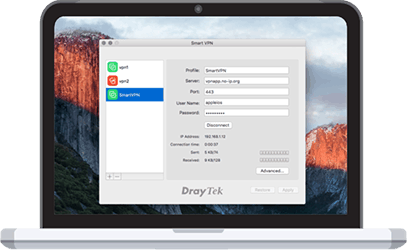
- #Advanced vpn client mac how to
- #Advanced vpn client mac pro
- #Advanced vpn client mac software
- #Advanced vpn client mac mac
This is utter garbage, as a Wireshark trace shows the Protected Mode negotiation, and then the fallback to Quick Mode: The connection attempt subsequently fails:

#Advanced vpn client mac mac
The Mac Networking applet claims the remote server is not responding.
#Advanced vpn client mac pro
My MacBook Pro is OS X 10.8, 圆4, fully patched.
#Advanced vpn client mac software
I'm not sure of the SonicWall's hardware or software level. The company has a SonicWall firewall/concentrator and I'm working on a Mac. My gateway is 10.0.1.1 - it is to the right of the "default" destination.I'm trying to get VPN access up and running. For example, here's what it looks like on my box right now: Internet:ĭestination Gateway Flags Refs Use Netif Expireġ0.0.1.1 0:1e:52:xx:xx:xx UHLWIi 55 520896 en1 481 The easiest way to figure out the gateway is to run netstat -rn before logging into the VPN, and look at the IP address to the right of the "default" destination. So you want to change your default route back to what it was prior to getting on the VPN. When you log into a VPN that prevents split-tunneling, it is enforcing that policy by changing your routing tables so that all packets are routed on the virtual interface. In Tuan Anh Tran's case, it looks like the network is "192.168.5.0/24".Īs for which gateway to specify in the second command, it should be your local gateway.

The "10" in the first command is the network that you want to route over the VPN. I have since left the job where I was using the Cisco VPN, so this is from memory.
#Advanced vpn client mac how to
I also found an explanation on how to run this automatically when you connect the VPN, but it's late on Friday and I don't feel like trying it :) I put it into a bash script, like this: $ cat vpn.sh Replace "192.168.0.1" with your local network's gateway. Replace "10" in the first command with the network that's on the other side of the tunnel. (I'm using OS X's built-in cisco client, not the Cisco branded client.) sudo route -nv add -net 10 -interface utun0 Run these after connecting to the cisco vpn. The VPN and everything else straight to the internet. What I want to do is have only 10.121.* and 10.122.* addresses over I found this thread ( ) that maybe could be an answer to your problem (if you use it to route the whole ip range):Īny one know how to hack the routing table (on a mac) to defeat theįorcing of VPN routing for every thing over a cisco VPN? pretty much The advanced button does not pop up with Cisco IPSec. The last one of these checkboxes is the one you want: "redirect all traffic over VPN". Select your VPN connection and click on the advanced button.Ī new window will pop up with three check-boxes under the heading "Session options".

The PPTP and L2TP do offer the option: Open your network settings: I guess not all VPN connections of the build-in VPN client in Mac have that option. So, what gives? Does this have to do with what kind of VPN I am connected to (Cisco IPSec)? Is it related to the VPN's settings? Regardless, how can I route normal browsing through the VPN? There is no options button or "Send all traffic over VPN connection" anywhere to be found. I see a dialogue with two tabs, "DNS" and "Proxies". However, when I select the VPN from the network interface list and click the "Advanced." button, there is no "Options" tab or button. This apple support page says there is a setting called "Send all traffic over VPN connection" which can be enabled through the Apple menu > System Preferences > Network > Advanced > Options dialogue. As far as I can tell, my regular web browsing is not being directed through the VPN. I would like to access other websites on the internet through this VPN (youtube, wikipedia, whatever). The VPN functions as expected, allowing me to access protected servers at my company. I'm attempting to change the settings of a Cisco IPSec VPN connection which was set up through OSX's built in VPN client in system preferences.


 0 kommentar(er)
0 kommentar(er)
